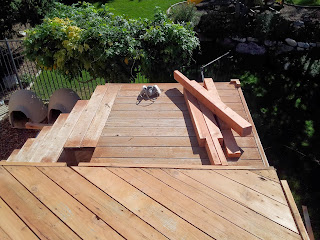I'm sure that many of our legions of dedicated followers did a spit take when they realized that we do lots of composite installations, especially after reading this post about the benefits of wood over composite. I am beginning to think the high end composite products are sweet, and seem to be overcoming many of the issues mentioned in my criticism.
Over the years I have seen decks in virtually every state of disrepair you can imagine. From pristine hardwood decks to the oldest redwood decks that are becoming one with the surrounding environment. In the process I have learned that some decks, despite my best heroic intentions, are beyond saving and must be torn out. It is in this situation that I am very open to composite, especially if I have a client that is fed up with dealing with staining and doesn't particularly care much for the aesthetic of wood. Composites are a great solution for these clients.
Lest we forget...
Composite has come a long way since the days where flaking away (shown above) was likely to happen on any given batch. Witnessing countless disasters like this have made us approach the composite market with caution from the beginning of our company. In addition to impeccable customer service, companies like Trex have advanced the technology to a point that has made it a much more attractive product for a certain segment of our clientele.
Durable outer coatings now wrap the raw composite material to defend against the common issues of rot, scratching, fading, and staining. This coatings also blocks moisture from entering the top surface which had been causing the boards to swell and move around on the frame. Many colors, grains and textures have increased the design potential and visual appeal of this medium greatly. Structural issues have been dealt with hopefully eliminating warping, cupping, or sagging. While I have yet to drink the koolaide completely I have now created space in our company for the use of composite decking.
Composite verses tropical hardwood
On price, high end Trex or Timbertech will be about the same as a tropical hardwood, although the price of ipe does fluctuate. The performance in my opinion is about the same as tropical hardwoods in terms of durability and work-ability as far as marring, crisp edges, and routing capability seen in both tropicals and composites. In terms of overall elegance and high end appeal I would put well installed and maintained tropical hardwood over the best composite installation but you do pay for it in terms of increased installation labor and tools, expensive fastening systems (if top fastened), and long term maintenance.
Border pieces, curved archways, inlays, and other patterns can be created using multiple colors and varieties of composite decking. Attempting to do this by using all redwood and different stain colors would create too much work for too little reward, since each board would need to be stained individually each time the deck was stained, and the contrast might not even show up very sharply anyway. Tropicals could be used to create borders and inlays either by using different species of tropical hardwood on the same project or using a mix of tropical and redwood or cedar. There are is range of colors and grains available in different tropical species and I think you will see more examples of mixed species decks (from us and others) in the future.
Downsides to composite, the material is super heavy and requires larger vehicles for transport. Also, this material is not wood, and I do love me some wood. Composite decking is a technological solution that has yet to be proven over the long term (20+ years) and if failures do occur, replacement is necessary. Wood on the other hand is malleable and can be worked with and restored in nearly any condition.
I digress, back to the project at hand.
After tear out on this deck we did an under coating of an oil based semi solid stain on the existing framing. Since the framing is relatively old it would have been a limiting factor in the overall life of a deck like this, and it would not be a fun task to remove the decking in order to rebuild the framing down the road. Top sheet removals always provide a valuable window of time to access the sub structure on ground levels decks. We do a full inspection to make sure everything was fastened well and that there are no rot issues. This is definitely the time to under coat if the frame is older and untreated even if it is pressure treated, which does require staining after one year. Luckily the builder used 2 x 10 pressure treated joists and double ledgers with many joists also being doubled. I have no doubt that this deck will last a long time.
Before
This deck is the trex transcend tropical with a border piece at the stair edge as visual element and also for safety. The tropical is up to $1.00 more and gives you the darker colored streaking in addition to the textured grain. This product goes in fairly easily using Trex hidden deck fasteners.
After
A splash of real wood...
Details
Date: October 2013
Trex Transcend tropical tiki torch with lava rock border piece
Undercoat cabot semi-solid grey pressure washed, mildewcide, dry time then stain sprayed on.





















































